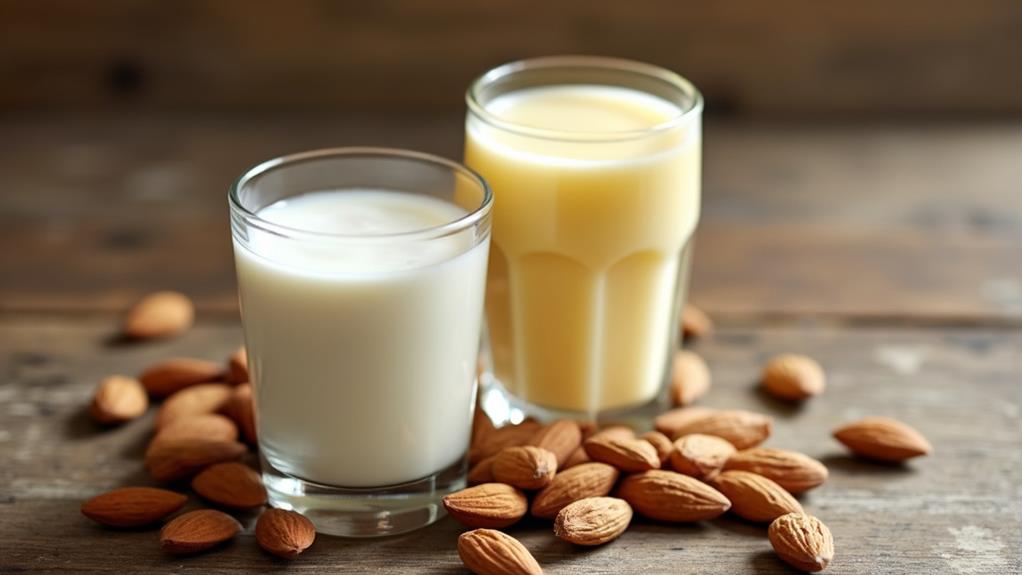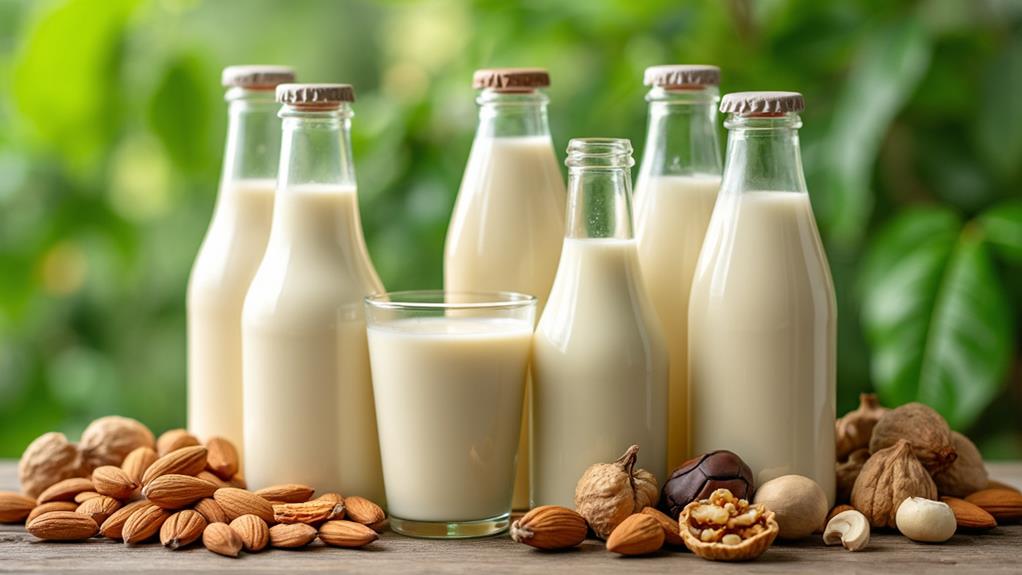Nut Milk Vs. Nut Juice: Understanding the Difference

When you think about nut-based beverages, you might picture the creamy texture of almond milk or the smooth consistency of cashew milk. But have you ever considered the difference between nut milk and nut juice? This distinction goes beyond mere terminology and involves variations in texture, nutritional content, and production methods. Nut milk is typically blended and strained to remove the pulp, resulting in a thicker, fortified drink. In contrast, nut juice retains the pulp, offering a thinner liquid with a simpler nutritional profile. Curious about what makes each unique? Let's explore this further.
What Is Nut Milk?
Nut milk, such as almond or cashew milk, is created by blending nuts with water and straining out the nut pulp, resulting in a creamy, opaque liquid similar to traditional cow's milk. Despite regulatory distinctions from dairy, the term "nut milk" is widely accepted due to its similar appearance and culinary uses.
Nutritionally, nut milk, especially almond milk, is lower in calories and fat than cow's milk, making it a popular choice for those seeking lighter alternatives or aiming to reduce calorie intake. Almond milk is particularly appreciated for its subtle, nutty flavor and versatility in both sweet and savory dishes.
Making nut milk at home is straightforward, requiring only nuts, water, and basic kitchen tools to blend and strain the mixture. This homemade method allows for control over flavor and additives, ensuring a pure and fresh product. Historically, nut milk was a valuable substitute for animal milk, especially during medieval times, due to the longer shelf life of nuts compared to perishable dairy products.
What Is Nut Juice?
Nut juice is a liquid derived from nuts through juicing or blending, resulting in a thinner consistency compared to nut milk. Unlike nut milk, it does not undergo a straining process, which means it has a less creamy texture and often contains lower levels of fat and protein. Despite these nutritional differences and its less common usage, nut juice holds a unique place in both history and culture.
Definition and Production Process
Ever wondered what nut juice really is? Nut juice refers to the liquid extracted directly from nuts through a specific production process. Unlike nut milk, which is created by emulsifying nuts with water and often involves straining out the pulp, nut juice is typically produced by soaking and grinding nuts in water without straining. This results in a thinner, less creamy consistency compared to the richer texture of nut milk.
The production process for nut juice is straightforward. Initially, the nuts are soaked in water to soften them. Then, they are ground with fresh water to extract the liquid. This mixture usually retains the nut pulp, providing a more natural and unadulterated taste. Unlike nut milk, nut juice generally doesn't include added sweeteners, flavors, or emulsifiers.
Because it's less processed, nut juice often has a different nutritional profile than nut milk, typically lower in calories and protein. While marketing and consumer preferences usually favor the term "nut milk," understanding the distinctions in production processes helps clarify why nut juice offers a unique alternative. Now you know what sets nut juice apart!
Nutritional Composition Differences
Compared to nut milk, nut juice is a simpler, less processed alternative with distinct nutritional differences. Nut juice, often seen as less appealing, is merely the liquid extracted from nuts without additional processing. This minimal processing means nut juice lacks the creamy texture and richness of nut milk.
Producing nut milk involves blending nuts with water and straining out the pulp, resulting in a nutrient-dense beverage containing emulsified fats, proteins, and sugars. Depending on the type of nut used, nut milk can offer varying levels of protein and fat, making it a richer source of nutritional benefits.
In contrast, nut juice generally lacks these nutritional advantages due to its simpler extraction process. Without emulsified fats and proteins, nut juice has a less diverse nutritional profile. Additionally, nut milk can be fortified with vitamins and minerals, enhancing its nutritional value, whereas nut juice typically does not undergo such fortification, further contributing to its less favorable perception.
Consumers often prefer nut milk for its creaminess and versatility in culinary uses, highlighting the stark differences in nutritional composition between nut milk and nut juice.
Historical and Cultural Context
The perception of nut juice is often overshadowed by its more processed counterpart, nut milk, which has a rich historical and cultural background. Nut milk, particularly almond milk, has served as a staple dairy substitute for centuries, providing an alternative to animal milk long before modern dietary trends. In contrast, the concept of nut juice, the straightforward liquid extracted from nuts without further processing, lacks this deep-rooted culinary significance.
Historically, almond milk:
- Dates back to medieval Europe: It was used in cooking and on fasting days.
- Was popular in the Middle East: Incorporated into diverse traditional dishes.
- Served as a reliable dairy substitute: Beneficial for cultures with lactose intolerance.
- Played a role in religious dietary practices: Offering a plant-based alternative.
Nut juice, however, doesn't enjoy such a storied past. Consumers find "nut juice" less appealing, affecting its market acceptance compared to the well-defined and nutritionally enriched nut milk. Furthermore, the expansion of the term "milk" to include non-animal sources by institutions like the Oxford English Dictionary further boosts nut milk's status over the relatively undefined nut juice. Consequently, the nutritional profiles and benefits of nut juices remain less recognized, overshadowing their potential in the growing plant-based market.
Key Differences

When exploring the key differences between nut milk and nut juice, several distinct characteristics set them apart. Nut milk, such as almond milk, is created by blending nuts with water and then straining the mixture to produce a creamy, opaque liquid. In contrast, nut juice refers to the unprocessed liquid extracted from nuts without blending and straining, resulting in a much thinner consistency.
One of the main differences lies in texture. Nut milk achieves a creamy consistency through the emulsification of fats and proteins, making it similar to traditional dairy milk. Nut juice, however, lacks this emulsification, so it doesn't have the same creaminess.
Nutritionally, nut milk often contains added vitamins and minerals, enhancing its nutritional profile. Nut juice, being less processed, generally isn't fortified and may not offer the same nutrient levels.
Marketing also plays a role. The term "nut milk" is widely accepted and marketed due to its similarity to animal milk. On the other hand, "nut juice" is less appealing to consumers and lacks recognition. Regulatory definitions, like those from the FDA, permit the use of "milk" for plant-based alternatives, emphasizing their distinct production methods.
Production Methods
Understanding the production methods of nut milk highlights its distinct characteristics. To make nut milk, you begin by soaking the nuts to soften them, which enhances the blending process. After soaking, blend the nuts with water until a smooth mixture forms. Then, strain the mixture to remove the nut pulp, resulting in a creamy liquid that resembles traditional milk.
Here's a quick breakdown of the nut milk production process:
- Soaking: Soak the nuts in water to soften them.
- Blending: Blend the soaked nuts with water until smooth.
- Straining: Strain the mixture to remove the pulp.
- Flavoring: Add optional sweeteners or flavorings to taste.
Homemade nut milk can be easily prepared using basic kitchen tools. Nut juice, on the other hand, is not a commonly used term and lacks a defined production method or consumer demand. This explains why nut milk remains the preferred choice for many.
Nutritional Comparison

Comparing nut milk to cow's milk reveals notable nutritional differences. Almond milk typically has a lower calorie content, with about 30-50 calories per cup, compared to cow's milk at approximately 148 calories per cup. This makes almond milk a lighter option for those monitoring their caloric intake.
In terms of protein, almond milk provides only about 1 gram per cup, whereas cow's milk offers a more substantial 8 grams. Therefore, if protein is a key component of your diet, cow's milk may be more beneficial.
Fat content also varies considerably. Whole cow's milk contains around 8 grams of fat per cup, while almond milk and other nut milks range between 2-5 grams per cup, making nut milks a leaner alternative for those mindful of fat intake.
Sugar content can also differ significantly. For example, oat milk might have up to 7 grams of sugar per cup, while unsweetened almond milk has little to no sugar. It's important to check labels, as fortified nut milks can provide essential nutrients like calcium and vitamin D.
Culinary Uses
Nut milk offers impressive versatility in culinary applications, enriching recipes with its rich flavors and creamy textures. Almond and cashew milk serve as excellent dairy substitutes in coffee, smoothies, and baked goods. Hazelnut and macadamia milk enhance lattes and desserts with their distinctive tastes. Cashew milk's thicker consistency is ideal for soups and sauces, while walnut milk introduces a sweet, flavorful twist to breakfast dishes and treats.
Versatility in Recipes
The versatility of nut milks in recipes elevates ordinary dishes into culinary masterpieces. Nut milks, such as almond, cashew, and walnut milk, provide excellent plant-based alternatives that enhance a variety of recipes. These alternatives excel in both sweet and savory dishes, making them essential in your kitchen.
- Smoothies: Almond milk and other nut milks offer a creamy, nutritious base that blends seamlessly with fruits and vegetables.
- Baked Goods: Replace dairy milk with almond or cashew milk in cakes, muffins, and breads to achieve moist, flavorful results without compromising texture.
- Sauces: Walnut milk, with its thicker consistency, adds creaminess to soups and sauces, making them rich and satisfying.
- Coffee Drinks: Macadamia milk's rich, buttery flavor froths beautifully in lattes and cappuccinos, providing a luxurious twist to your morning brew.
Hazelnut milk's unique flavor profile pairs perfectly with chocolate, making it an excellent choice for desserts and beverages like hot chocolate. Many nut milks can be easily made at home, allowing you to customize flavors and sweetness to suit your dietary preferences. Embrace the versatility of these plant-based milk alternatives to elevate your culinary creations.
Flavor and Texture
Experience the indulgence of nut milks in your culinary creations, where flavor and texture make all the difference. Nut milks, such as almond and cashew milk, offer a creamy texture perfect for lattes, smoothies, and sauces. Their richness provides a satisfying mouthfeel, elevating your dishes beyond what nut juices can offer. Imagine the smoothness of cashew milk seamlessly blending into your soups, creating a harmonious base that enhances other flavors without overpowering them.
The diverse flavor profiles of nut milks can uniquely enhance your culinary repertoire. For example, macadamia milk offers a rich, buttery taste that elevates your morning coffee or dessert recipes. Hazelnut milk delivers a velvety, slightly toasted flavor, making it an exceptional choice for hot cocoa or Nutella-inspired drinks. These creamy nut milks not only enhance beverages but also elevate baked goods and enrich soups, making them more indulgent.
Incorporating nut milks into your cooking results in a richer, more satisfying experience. Their depth of flavor and creamy texture surpass the thin, less rich consistency of nut juices, ensuring your dishes are both delicious and memorable.
Popular Nut Milks

Have you ever wondered why nut milks have surged in popularity as dairy alternatives? The answer lies in their distinctive flavors, impressive nutrient profiles, and versatility. Let's explore some of the most popular nut milks:
- Almond Milk: This dairy substitute features a mildly nutty flavor, low-calorie content, and a rich nutrient profile. Typically made by blending almonds with water and straining the pulp, it's perfect for smoothies or cereals.
- Cashew Milk: Renowned for its creamy texture and thick consistency, cashew milk is ideal for recipes like CocoCash™ Milk and Cashew Golden Milk. It's also celebrated for its anti-inflammatory properties.
- Macadamia Milk: With a rich, buttery flavor and high heart-healthy fat content, macadamia milk is excellent for frothing in coffee or using in desserts. Its luxurious taste makes it a favorite among nut milk enthusiasts.
- Hazelnut Milk: Offering a velvety, slightly toasted flavor, hazelnut milk is packed with vitamins and minerals. It's a sweet addition to coffee or hot cocoa, often referred to as Nutella milk.
These nut milks not only serve as excellent dairy alternatives but also enrich your diet with unique flavors and health benefits.
Consumer Preferences
Many people choose nut milks over traditional dairy due to their perception as creamy, nutritious beverages. This aligns with what consumers seek in dairy alternatives. The term "nut milk" is favored because it meets expectations for both texture and health benefits. The rise of plant-based diets has significantly increased the popularity of nut milks, with sales in the plant-based milk category reaching $2.6 billion in 2021.
Often, people choose nut milks for dietary reasons such as lactose intolerance or ethical concerns about animal welfare. This shift reflects broader changes in consumer preferences. Health-conscious individuals are more likely to scrutinize labels, looking for unsweetened options rich in vital nutrients. Almond and oat milk are popular choices due to their appealing flavors, nutritional profiles, and transparent ingredient lists.
Historical Context

Throughout history, almond milk and other nut milks have played significant roles in various cultures due to their shelf stability and versatility. In contrast to perishable animal milk, nut milks provided a long-lasting alternative, crucial before the advent of refrigeration. Historical recipes often combined almonds and water to create a mild, emulsified liquid suitable for diverse dishes. This practice was not merely about convenience but also deeply rooted in culinary traditions.
In Medieval Europe, almond milk was widely used in:
- Sauces and soups - to enhance flavor and texture.
- Desserts - to provide a creamy consistency without dairy.
- Lenten dishes - to comply with religious dietary restrictions.
- Medicinal concoctions - believed to offer health benefits.
Distinct cultures around the world have their own rich histories with plant-based milks. In Asia, for example, nut and grain-based milks have been consumed for centuries. These traditions highlight the global importance of nut milks, especially for those with lactose intolerance or dairy allergies, long before modern alternatives became available.
The use of almond milk as a substitute for animal milk illustrates human ingenuity and adaptability. By blending almonds and water, societies met their dietary needs, showcasing both necessity and innovation over time.
Regulatory Definitions
The use of the term "milk" for nut milks, such as almond milk, has generated significant debate, particularly regarding regulatory definitions. The FDA maintains that almonds cannot produce milk since they do not lactate, challenging traditional definitions based on animal production. Regulatory definitions aim to clearly distinguish between traditional dairy milk and plant-based alternatives. Consequently, products like almond milk must be labeled to accurately reflect their nutritional content, which often differs from that of cow's milk.
Proposed FDA guidelines suggest that plant-based milks should clearly indicate their nutritional differences compared to cow's milk. This includes noting lower levels of Vitamin D and calcium. Despite this, the term "milk" for plant-based alternatives has gained acceptance in marketing because these products fulfill similar dietary roles.
Comparison of Dairy Milk and Almond Milk
| Aspect | Dairy Milk | Almond Milk |
|---|---|---|
| Source | Animal (cows) | Plant-based (almonds) |
| Lactose Content | Contains lactose | Lactose-free |
| Vitamin D & Calcium | Higher levels | Generally lower levels |
| Regulatory Labeling | Standardized | Requires clarification of differences |
Industry groups, such as the National Milk Producers Federation, oppose the use of dairy terminology for plant-based alternatives, fueling ongoing discussions about labeling practices.




